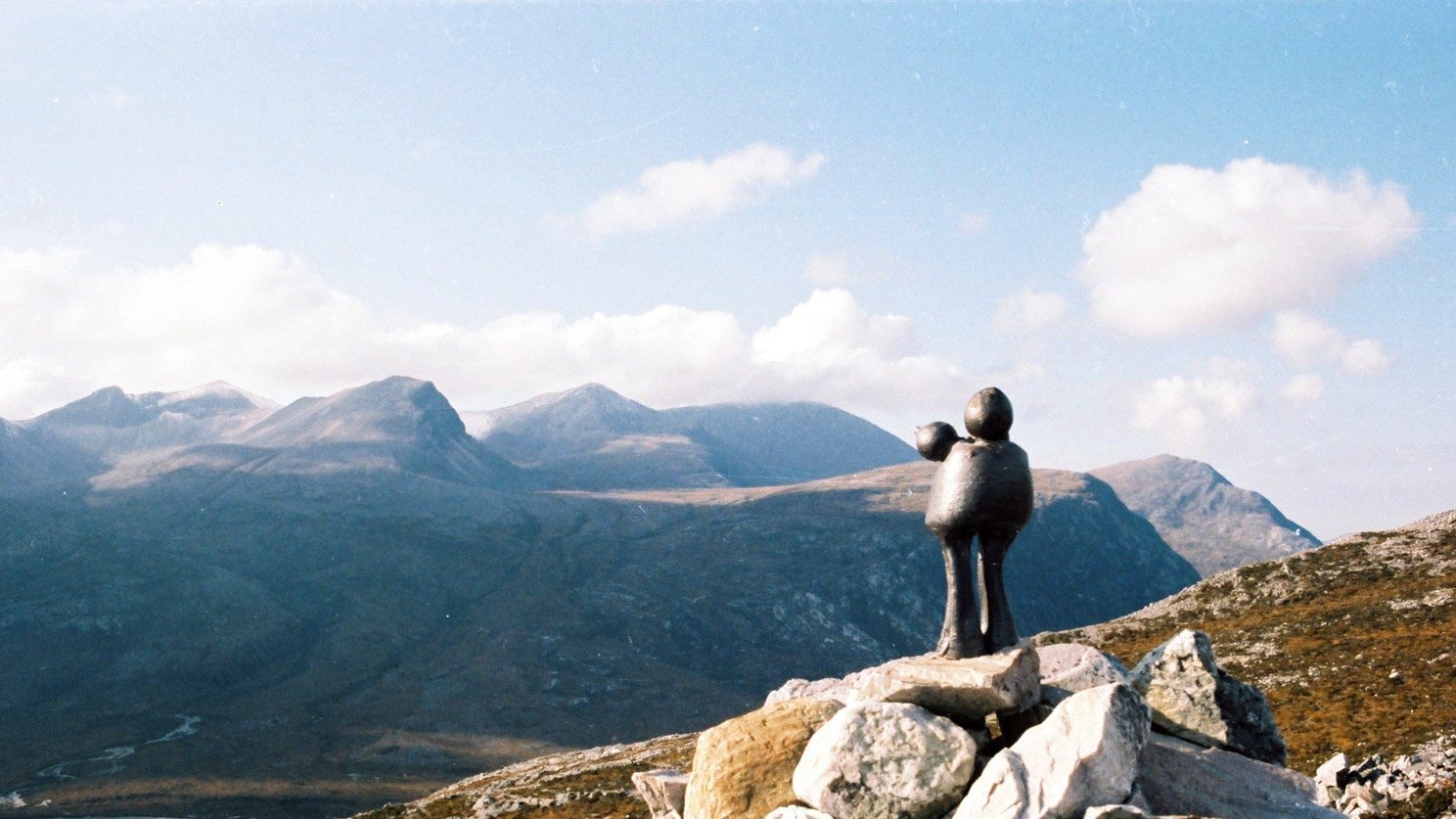It is not always easy, with Lotte Glob’s ceramics, to know what you’re looking at. Like so many things in the natural world, they are rich and strange – and most likely to be found outside: sightless orbs with cloven feet hidden in heather; craggy dish-like sculptures, rockpool centres puddled with blue; a book (or is it?), its pages ossified, lodged in a stony crevice in the Sculpture Croft, her home on the edges of Loch Eriboll, near Durness in northern Scotland.
That these artworks are hard to categorise comes as no surprise. Lotte has never liked rules. Born in Denmark in 1944, she hated school so much she left at 14. It didn’t take long to work out what she should do next, though. Since she was small, Lotte had been mesmerised by clay, making things out of the clods she’d find outside and firing them with explosive results in her mother’s Rayburn. Eventually, she begged her mother for a wheel, ‘sat in the shed and started practising’.
The woman she apprenticed for was Gutte Eriksen – a celebrated studio potter and Denmark’s answer to the likes of Leach and Rie. The experience was formative, teaching Lotte how to transform earth into something with aura. A few years later, she went to work in an old-fashioned slipware factory, before she left Denmark aged 19, intent on ‘travelling the world, from pottery to pottery’.
She managed it, landing first in southern Ireland. Not speaking a word of English (and embarrassed to do so in front of the teenaged boys of the family she was lodging with), Lotte didn’t speak for two months, listening instead. Knowing she would have to learn eventually, she hitchhiked to hostels – where she had to make conversation – at weekends, spending the days walking and drawing in the uplands of County Cork. After six months, Lotte’s feet were itchy again. Scotland, and a pottery on west coast, beckoned. She was warned not to bother; ‘people said it was too wild, there was nothing there. The more they said it, the more I had to go.
Upon arriving, ‘I knew I’d come home.’ Lotte had loved the mountains since she’d first encountered them as a child on holiday in Norway – their vastness, their emptiness, their sounds and smells – but she also fell for the sense of freedom she encountered in Scotland. ‘There were so few rules when I arrived,’ she says, romantically. ‘Everyone was so relaxed – you could go anywhere and live anywhere. You could live in a cave, if you wanted. You really could live simply if you wanted.’
Having met her partner, himself a potter, and had children, Lotte eventually made a home on an ex-military camp near Durness. In the 36 years she lived there, Lotte continued to look to the land when making her work. She insists the connection between her work and the world around them isn’t necessarily linear – her forms aren’t copied shapes, for instance – but, exactly as she did in Ireland, ‘I just listen’, waiting to see what her hands form. Of course, there is a more obvious connection too: Lotte’s material is intrinsically of the earth, as are her glazes, which she has always made herself from rocks and minerals. At some point, those rocks and minerals began making their way into the sculptures intact too. ‘It was such hard work grinding them to dust that I thought: ‘Why don’t I just leave them whole?’ A friend, who’s an expert told me I couldn’t. So I did.’
Life at the camp, out in the Highlands, suited Lotte. Once her children had grown up and Lotte had split from their father, she continued to live and sculpt there, sleeping outside in the hills in summer, spending the days in her studio. But something niggled. ‘I had always wanted a bit of land for myself.’
Lotte explains how her mother had always liked seeing her daughter’s sculptures outside. And the potter herself had, since childhood, been creating ‘little gardens’ from roots and sticks and shells. The idea of doing it on a grander scale took hold, which was how she ended up on the plot she now calls home. ‘Oh, that was a wonderful moment,’ she says. ‘Suddenly, I had a 12-acre canvas to play with.’
Munched on by roaming sheep and deer, it was desert-like. The first thing Lotte did was put up a fence to keep the animals out. Then she bought a pencil. ‘It became my strimmer,’ she says, explaining how she used it to map out paths to be cleared around the croft. The planting of 5,000 trees followed, as did the creation of an extraordinary wooden house on stilts, designed with the help of architect Gökay Deveci – as close to a caravan as it gets. But first, before there was a house, there was a kiln (wood-fired, integral in achieving the fiery flecks and unpredictable patinas Lotte strives for).
Now, there’s a sauna on the beach and a solar dome too, where sculptures live alongside tomato plants. There are sculptures everywhere, in fact: in the grass, on the heathland, beside paths and settled into rocks. The idea was always that people could visit, as ‘it beats having exhibitions,’ she says. ‘And, working in isolation, it’s good to have people around sometimes.’ Lotte pauses. ‘Saying that, I could probably do with more isolation,’ she laughs. ‘I have a big family, lots of friends – I’m not lonely.’ Besides, how could she be? There’s always the landscape.
Lotte Glob’s Sculpture Croft is open by appointment only. For more information, visit lotteglob.co.uk
